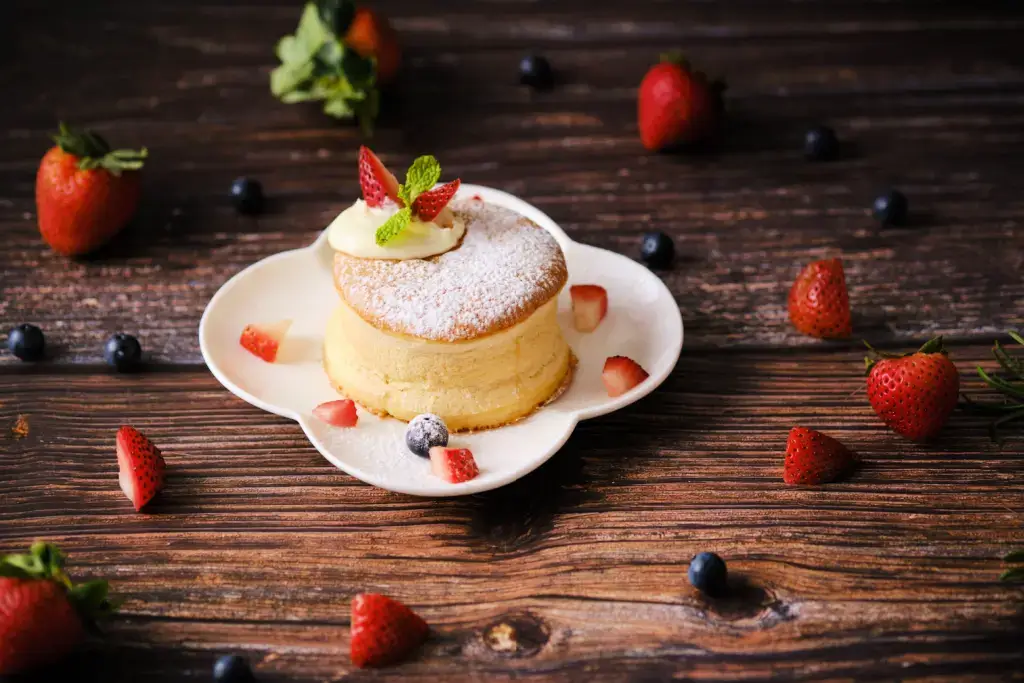japanese pancakes
Japanese Pancakes: Everything You Need to Know!

Savannah Walker
Posted on February 06, 2024
Share:

Among the treasures of cuisine, Japanese pancakes are a delightful phenomenon. But how did this beloved breakfast delight become a culinary sensation in Japan? Join us in viewing these heavenly treats, a blend of history, craftsmanship, and pure joy in a culinary masterpiece!
How did pancakes make it to Japan?
The story of Japanese pancakes unfolds against Japan’s rich culinary history. Initially introduced by Western influences, pancakes transformed, seamlessly blending with the precision and finesse inherent in Japanese culinary traditions.

Pancakes turned into a canvas for chefs to get creative, blending the simple tastes of Japan with the yummy style of a Western breakfast favorite. The outcome was a perfect mix of old and new! As a result, pancakes went from being something brought in to a Japanese culinary masterpiece.
What’s the difference between pancakes in Japan and the West?
So, what sets Japanese pancakes apart from their Western counterparts? The answer lies in the preparation and the infusion of distinct flavors. Japanese pancakes, known for their fluffiness and airy texture, result from a harmonious dance between carefully selected ingredients and precise culinary techniques.
Unlike traditional pancakes, Japanese versions often incorporate soufflé-like qualities, creating a unique sensory experience. The key lies in using egg whites, whipped to stiff peaks, and abundant eggs in the batter. This meticulous approach results in a texture that is light, airy, and almost ethereal.

Adding vanilla extract, sugar, and baking powder adds a bit of sweetness to make the pancakes taste better. Beating the egg whites until stiff is crucial to make the pancakes fluffy and hold their shape while cooking.
Mixing the yolk mixture with the beaten egg whites is like doing a cooking dance. It keeps the pancakes light and adds a rich taste. Using a ring mold when cooking ensures all the pancakes look the same, making them tasty and nice.
Are you looking for amazing snacks like Japanese pancakes? Check out Sakuraco! Sakuraco delivers traditional Japanese snacks, teas, sweets, and snacks from local Japanese makers directly to your door so you can enjoy the latest treats directly from Japan!
Which Japanese foods use pancakes?
The versatility of pancakes extends beyond the breakfast table in Japan, finding its way into a myriad of delectable creations. From towering soufflé pancakes to bite-sized dorayaki, these fluffy delights have become a versatile canvas for culinary innovation. Chefs blend tradition with modern creativity, showcasing pancake artistry in various culinary settings, from bustling street food stalls to refined dessert parlors.
Soufflé Pancakes

Elevating the pancake experience to new heights, soufflé pancakes are a culinary spectacle. Their ethereal lightness also comes from using egg whites meticulously, creating a delicate balance that defines their distinctive texture. These cloud-like pancakes transform into a symphony of flavor and elegance when adorned with whipped cream, maple syrup, and vanilla extract.
Dorayaki

In traditional Japanese sweets, dorayaki also emerges as a pancake-based delight. Generally, these castella pancake sandwiches, often filled with velvety azuki red beans, epitomize the seamless fusion of Western pancake influences with Japanese tradition. As a result, dorayaki is a delightful mix of textures and tastes that captivates the palate.
Okonomiyaki

Venturing into savory realms, okonomiyaki also showcases pancakes in a different light. Moreover, these savory delights feature a batter infused with ingredients like shredded cabbage, meats, and a flavorful sauce. Okonomiyaki undoubtedly shows how versatile pancakes are, proving that these delicate creations can be equally at home in sweet and savory realms.
Negiyaki

Negiyaki is a savory pancake that originates from the city of Osaka in Japan. It is similar to okonomiyaki but is characterized by using green onions or leeks as the core ingredient. The pancake is made of flour, eggs, dashi, yam, and green onions, and it is typically fried on a hot plate. The dish can also be customized with various toppings such as pork, shrimp, or tofu, and it is often served with soy-based sauce and additional green onions.
Why are Japanese pancakes special?
Overall, Japanese pancakes go beyond ordinary breakfast, embodying sophistication and artistry. The attention to detail, diverse flavors, and commitment to perfection contribute to their allure. Each bite is a journey of Japanese culinary refinement. Quality ingredients and precision in execution also result in pancakes that delight the senses.

Savoring each bite immerses you in Japan’s culinary heritage, where every dish tells a story. Therefore, every flavor evokes a sense of tradition and innovation. Have you enjoyed savoring these culinary marvels, or do you plan to have your pancake-making adventures? The world of Japanese pancakes is as diverse as delectable, and we look forward to your thoughts!

Discover authentic flavors with Sakuraco
Get Sakuraco 

Discover authentic flavors with Sakuraco
Get Sakuraco 
Related Articles

Otoro Sushi: Why Is It Worth Trying at Least Once?
Otoro sushi is one of Japanese cuisine’s most luxurious and talked-about items. This cut of tuna is considered one of the top choices for sushi lovers.

Shochu Time: Why Japan Loves This Drink
One of the most well-loved souvenirs people often think of from Japan is sake, a traditional alcoholic beverage. However, there is another type of alcohol that has become so popular in Japan that it now sells more than sake. That drink is shochu. To learn more about this special beverage, keep reading!

Shikuwasa: A Citrus Delight from Okinawa
In Okinawa, the fruit shikuwasa is widely used in various kinds of food and drink. Let’s explore this remarkable Okinawan fruit in more detail!

Japanese Vegetables: Awesome Picks for Hot Days!
People often crave cool foods and drinks to beat the heat in summer. Vegetables are always one of the top ingredients and essential in summer cuisine. This season offers a wide variety of delicious and healthy vegetables. Let’s explore some of the most popular Japanese vegetables in summer dishes!



